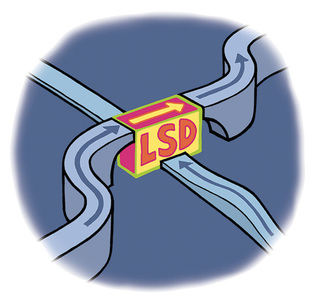 loading
loading
FindingsThis is your brain on LSD researchScientists take another look at a drug associated with ’60s counterculture.  Gregory NemecView full imageLong associated with “turning on, tuning in, and dropping out,” LSD has the potential to provide insights into the workings of the brain and the mechanisms that underlie certain mental illnesses. The experiences of an LSD “trip”—hallucinations, distorted experiences of sound and color, and a warped sense of time—show some similarities to changes that occur with disorders such as schizophrenia. To understand what happens when LSD creates these perceptual distortions—and gain deeper insight into both overall brain function and the biology of psychoses—a team from Yale and the University of Zurich examined effects of LSD on the brains of healthy study participants. Their findings were published in the journal eLife. Two dozen subjects in their 20s and 30s were randomly given either LSD, a placebo, or a combined dose of LSD and ketanserin. Ketanserin blocks the effects of LSD by preventing the LSD molecules from attaching to a particular receptor (serotonin 2A). Using brain imaging technology and post-experience surveys, they found two effects in those who took only LSD: reduced communication between brain regions that control cognitive processes, and increased connectivity among brain networks associated with movement and sensory functions. They also found strong similarity between the placebo group and the group given both LSD and ketanserin. This finding—that serotonin 2A is a major player in LSD “trips”—may spur new research into mental health therapies. LSD’s effects were known as far back as the 1940s, but research stalled in the 1960s, partly because of the association with 1960s counterculture. Professor John Krystal, chair of psychiatry at the Yale School of Medicine and a collaborator on the study, says the new results close gaps in understanding: “This study validates for the first time the ability to link a pattern of brain activity to a specific underlying molecular mechanism.”
The comment period has expired.
|
|